Gerard ter Borch
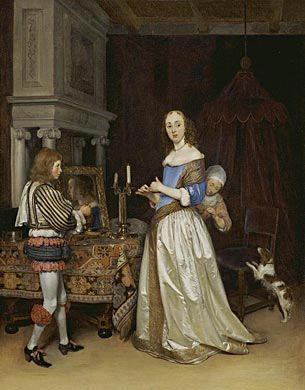
A Lady at Her Toilet, c. 1660, oil on canvas, 30 x 23 1/2 in., The Detroit Institute of Arts, Founders Society Purchase, Eleanor Clay Ford Fund, General Membership Fund, Endowment Income Fund and Special Activities Fund
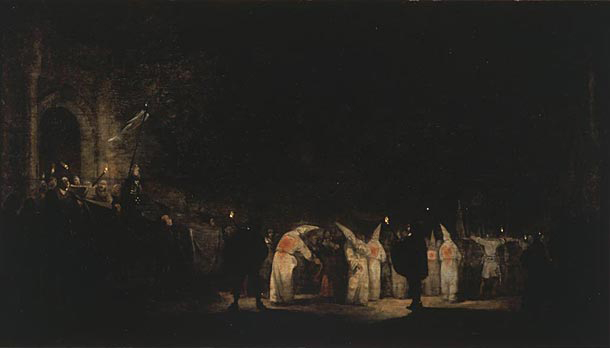
Procession with Flagellants, c. 1636/1640, oil on panel, 16 5/16 x 28 1/8 in., Museum Boijmans Van Beuningen, Rotterdam
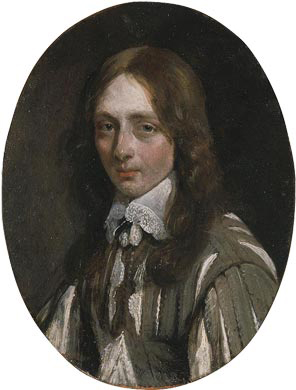
Caspar van Kinschot, 1646/1647, oil on copper, 4 5/6 x 3 1/8 in., Private collection, on long-term loan to the Royal Cabinet of Paintings Mauritshuis, The Hague
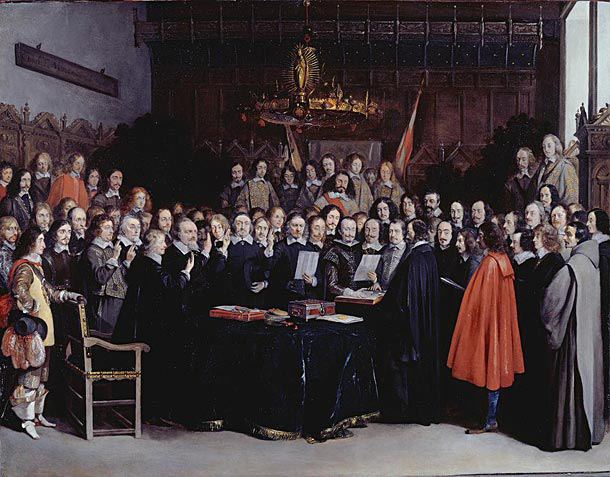
The Swearing of the Oath of Ratification of the Treaty of Münster, 15 May 1648, 1648, oil on copper, 17 7/8 x 23 1/16 in., The National Gallery, London
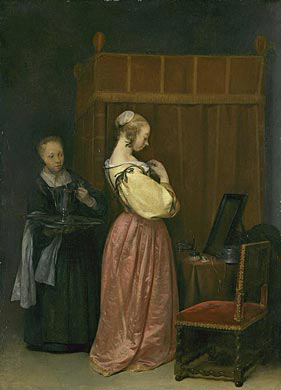
A Young Woman at Her Toilet with a Maid, c. 1650/1651, oil on wood, 18 3/4 x 13 5/8 in., Lent by the Metropolitan Museum of Art, New York, Gift of J. Pierpont Morgan, 1917

The Grinder’s Family, c. 1653, oil on canvas, 28 15/16 x 23 15/16 in., Staatliche Museen Zu Berlin-Preussischer Kulturbesitz, Gemäldegalerie
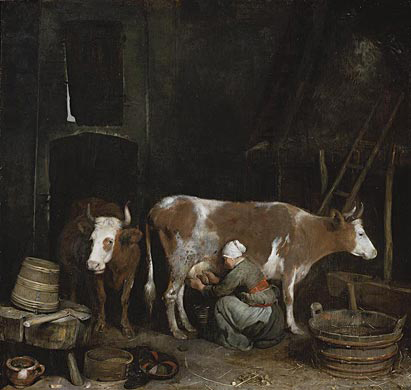
A Maid Milking a Cow in a Barn, c. 1653/1654, oil on panel, 18 11/16 x 19 3/4 in., The J. Paul Getty Museum, Los Angeles
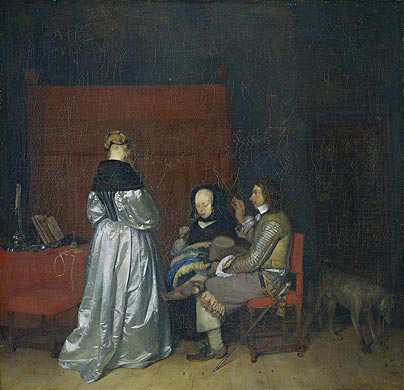
Gallant Conversation (known as Paternal Admonition), c. 1654, oil on canvas, 27 15/16 x 28 3/4 in., Rijksmuseum, Amsterdam

Gerard ter Borch's paintings often allude to music, a common seventeenth-century metaphor for love and harmony between family members, lovers, or friends. In The Suitor's Visit, the arrival of a gentleman has interrupted a duet. A young woman has risen to greet him, leaving her bass viol and sheet music on the table, while her seated friend continues to strum a lute. In the seventeenth century, both the lute and viol often accompanied singing. Listen to a soloist singing to the accompaniment of seventeenth-century Dutch music played on instruments similar to those in Ter Borch’s painting.
Music: "Queen Alcyone’s Dream" from Haarlem Winter Flowers, 1645/1647; performed by Camerata Trajectina, Pickled Herring, Music from the time of Frans Hals, 2003 (MP3 832k) Audio help
The Suitor's Visit, c. 1658, oil on canvas, 31 1/2 x 29 1/2 in., Andrew W. Mellon Collection, 1937.1.58
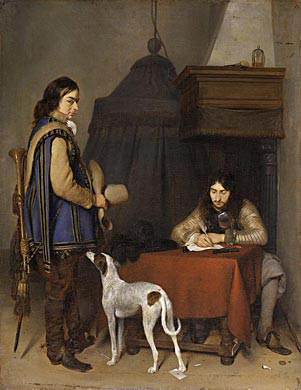
Officer Writing a Letter, c. 1658/1659, oil on canvas, 21 5/8 x 18 15/16 in., Philadelphia Museum of Art, The William L. Elkins Collection, 1924
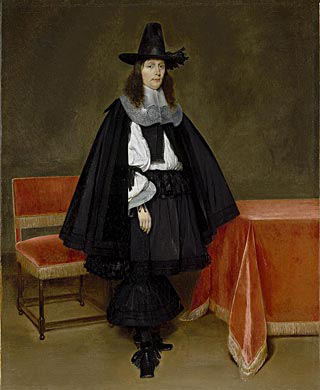
Portrait of a Young Man, c. 1663, oil on canvas, 26 1/2 x 21 3/8 in., The National Gallery, London
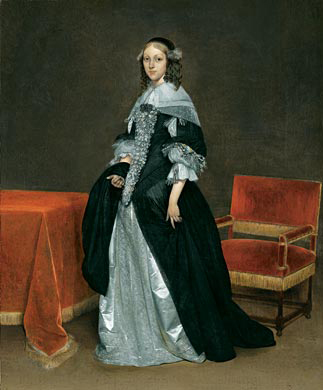
Portrait of a Young Woman, c. 1663, oil on canvas, 24 15/16 x 20 3/4 in., The Cleveland Museum of Art, The Elisabeth Severance Prentiss Collection
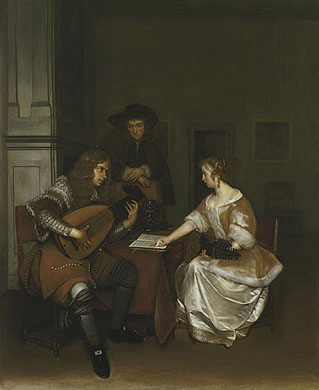
Ter Borch often repeated figures from one painting to another. Both The Music Lesson and The Music Party contain nearly identical images of a young woman holding a French lute as she reaches to turn a page of sheet music. This instrument probably belonged to the artist or a member of his family, as it appears in several of his paintings. The woman and her lute-playing teacher are engaged in a musical duet, implying that their hearts are also attuned to each other. Listen to two selections of seventeenth-century Dutch music composed for two lutes.
Music: A Lark has Died and The Angry Horse from the Lute Book of Johan Thysius (1621 - 1653); performed by Camerata Trajectina, Pickled Herring, Music from the time of Frans Hals, 2003 (MP3 544k and 1.1MB) Audio help
The Music Lesson, c. 1668/1669, oil on panel, 22 7/8 x 18 5/8 in., The Toledo Museum of Art, Purchased with funds from the Libbey Endowment, Gift of Edward Drummond Libbey
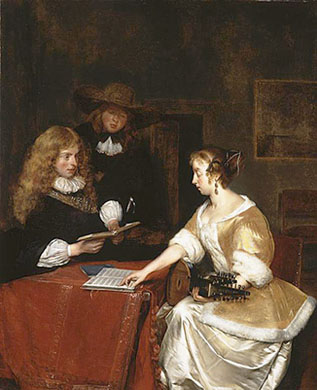
Many seventeenth-century songbooks were entirely devoted to love songs because musical gatherings offered prime opportunities for flirtatious social encounters between men and women. Here, the two young men are apparently singing, although the gaze of the seated youth suggests that his interest lies more with the young woman than with the songbook in his hands. The woman plays a French lute, which has a separate pegbox for a set of longer bass strings. This instrument was especially popular in the seventeenth and early eighteenth centuries when it served mainly to accompany another musical instrument or singing. Listen to two selections of seventeenth-century music. The first selection is of a French lute; the second selection is a vocal with lute accompaniment.
Music: Nicholas Hotman (died 1663), Courante; performed by Camerata Trajectina, Music from the Golden Age, 1992 (MP3 544k) Audio help
Constantijn Huygens (1596 - 1687), What shall we do?, 1640; performed by Camerata Trajectina, Music from the Golden Age, 1992 (MP3 2.1MB) Audio help
The Music Party, c. 1668/1670, oil on panel, 22 7/8 x 18 5/8 in., Cincinnati Art Museum, Bequest of Mary M. Emery